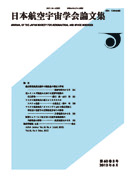All issues

Volume 37, Issue 423
Displaying 1-5 of 5 articles from this issue
- |<
- <
- 1
- >
- >|
-
Mototsugu ITO1989Volume 37Issue 423 Pages 163-171
Published: April 05, 1989
Released on J-STAGE: December 16, 2010
JOURNAL FREE ACCESSDownload PDF (10066K) -
Norikazu SUDANI, Shigeaki NOMURA, Koichi HOZUMI, Akira MURAKAMI, Yasuh ...1989Volume 37Issue 423 Pages 178-185
Published: April 05, 1989
Released on J-STAGE: December 16, 2010
JOURNAL FREE ACCESSAn experimental study has been made on aerodynamics of a cruising type hypersonic transport configuration, assuming to cruise at a height of 30km at Mach number 7. The hypersonic flow over the double-delta wing which is a basic wing shape of HST has been investigated. The results of the flow visualization (oilflow, vapor screen, etc.) and the quantitative measurements (static pressure and heat transfer) show that the vortices of the leeward side of the double-delta wing influence on aerodynamic forces, and that they are associated with the intence local heating along the centerline. From the wind tunnel test of the HST model at Mach number 7, it is confirmed that the geometry of the model almost satisfies the requirements of aerodynamic characteristics under hypersonic cruising. In parallel with the experiments, a basic study on aerothermodynamic control of the performance has been made. The results show that the static pressure rises with heat addition to the stream beneath the afterbody of the HST, and suggest possibility of improving lift-to-drag ratio.View full abstractDownload PDF (14630K) -
Hiroyuki SHIRAI, Katsuine TABEI1989Volume 37Issue 423 Pages 186-192
Published: April 05, 1989
Released on J-STAGE: December 16, 2010
JOURNAL FREE ACCESSNonequilibrium radiation of nitrogen plasmas generated by the Maecker type plasma generator was studied mainly by a spectroscopic method. It was found that the plasma generator, if operated under the low-pressure and low-discharge current conditions, could produce high temperature and significantly nonequilibrium nitrogen plasmas. Theoretical and experimental intensity distributions of N2 and N2+ band systems agreed very well, indicating the validity of the nonequilibrium dissociative rate constants and collisional-radiative process model included in the theory.View full abstractDownload PDF (8174K) -
Takahira AOKI, Kyohei KONDO1989Volume 37Issue 423 Pages 193-201
Published: April 05, 1989
Released on J-STAGE: December 16, 2010
JOURNAL FREE ACCESSA new, simple method for calculating strain energy release rates due to delamination propagating from free edges of composite laminates under uniform axial extension is presented. Saturated values associated with the delamination growths are given by the use of classical lamination plate theory and the J-integral. Numerical example shows good agreement with the finite element analysis. The method is extended to calculate energy release rate due to delamination around holes. Free edge delamination under pure bending is also considered and the calculated values are compared with those from finite element analysis. Owing to the simplicity, the present method is suitable for preliminary design analysis, which requires a lot of configurations to be examined.View full abstractDownload PDF (3077K) -
Ryojiro AKIBA1989Volume 37Issue 423 Pages 202-204
Published: April 05, 1989
Released on J-STAGE: December 16, 2010
JOURNAL FREE ACCESSSimplified equations of energy and momentum conservation lead to a closed form expression of effective exhaust velocity of an air breathing engine which characterizes an aerospaceplane. Following features of hypervelocity propulsion are disclosed. First, the intake air is effective as an oxygen carrier, a momentum carrier and an energy carrier depending on the flight velocity. Second, actual thermochemical values allow only hydrogen to be the fuel of an aerospaceplane. Third, efficiency of energy utilization for intake air must exceed 90% in order to reach near an orbital speed.View full abstractDownload PDF (2108K)
- |<
- <
- 1
- >
- >|